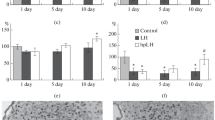The effects of acclimatization to middle attitude hypoxia on the resistance to acute emotional stress were studied on the model of posttraumatic stress disorder in rats. Anxyolitic, but not anxiogenic effect was observed in acclimatized rats. However, acclimatized rats with posttraumatic stress disorder were characterized by hypofunction of the pituitary—adrenocortical axis, which is typical of this pathology, and reduction in corticosterone/dehydroepiandrosterone ratio. At the neuroendocrine level, up-regulation of glucocorticoid receptors and a decrease in the level of corticotropin-releasing hormone in the hippocampus were revealed. The observed modifications of regulatory mechanisms can underlie hypofunction of the pituitary—adrenocortical axis. It was concluded that acclimatization to middle attitude hypoxia masks behavioral symptoms of posttraumatic stress disorder, but does not alter its pathogenetic neuroendocrine mechanisms.
Similar content being viewed by others
References
Kozlov AI, Kozlova MA. Cortisol as a marker of stress. Human Physiol. 2014;40(2):224-236.
Matyushchenko NS, Zakirov DZ, Kuchuk EM, Namatova N. Combined biological effects of environmental factors on the functional state hypothalamic-pituitary-adrenocortical system. Ulianov Med.-Biol. Zh. 2012;(2):17-23. Russian.
Meerson FZ. Adaptation, Stress, and Prophylaxis. Moscow, 1981. Russian.
Mironova VI, Rybnikova EA. Permanent modification of neurohormone expression in the hypothalamus of rats on the model of learned helplessness. Bull. Exp. Biol. Med. 2008; 146(4):388-390.
Rybnikova EA, Mironova VI, Tyul’nikova EI, Samoilov MO. Anxiolytic effect of moderate hypobaric hypoxia in rat model of post-traumatic stress disorder. Zh. Vyssh. Nervn. Deyat. 2008;58(4):486-492. Russian.
Eagle AL, Knox D, Roberts MM, Mulo K, Liberzon I, Galloway MP, Perrine SA. Single prolonged stress enhances hippocampal glucocorticoid receptor and phosphorylated protein kinase B levels. Neurosci. Res. 2013;75(2):130-137.
Balaz V, Balazova E, Blazicek P, Kvetnansky R. The effect of one-year acclimatization of rats to mountain conditions on plasma catecholamines and dopamine beta-hydroxylase activity. Catecholamines and Stress: Recent Advances. Usdin E, Kvetnansky R, Kopin IJ, eds. New York, 1980. P. 259-264.
Cheng W, Han F, Shi Y. Neonatal isolation modulates glucocorticoid-receptor function and synaptic plasticity of hippocampal and amygdala neurons in a rat model of single prolonged stress. J. Affect. Disord. 2019;246:682-694.
Geracioti TD Jr, Baker DG, Kasckow JW, Strawn JR, Jeffrey Mulchahey J, Dashevsky BA, Horn PS, Ekhator NN. Effects of trauma-related audiovisual stimulation on cerebrospinal fluid norepinephrine and corticotropin-releasing hormone concentrations in post-traumatic stress disorder. Psychoneuroendocrinology. 2008;33(4):416-424.
Liberzon I, Krstov M, Young EA. Stress-restress: Effects on ACTH and fast feedback. Psychoneuroendocrinology. 1997;22(6):443-453.
Mironova V, Rybnikova E, Pivina S. Effect of inescapable stress in rodent models of depression and posttraumatic stress disorder on CRH and vasopressin immunoreactivity in the hypothalamic paraventricular nucleus. Acta Physiol. Hung. 2013;100(4):395-410.
Nahvi RJ, Nwokafor C, Serova LI, Sabban EL. Single prolonged stress as a prospective model for posttraumatic stress disorder in females. Front. Behav. Neurosci. 2019;13. ID 17. doi: 10.3389/fnbeh.2019.00017
Author information
Authors and Affiliations
Corresponding author
Additional information
Translated from Byulleten’ Eksperimental’noi Biologii i Meditsiny, Vol. 168, No. 11, pp. 551-555, November, 2019
Rights and permissions
About this article
Cite this article
Rybnikova, E.A., Zenko, M.Y., Barysheva, V.S. et al. Acclimatization to Middle Attitude Hypoxia Masks the Symptoms of Experimental Posttraumatic Stress Disorder, but Does Not Affect Its Pathogenetic Mechanisms. Bull Exp Biol Med 168, 614–617 (2020). https://doi.org/10.1007/s10517-020-04763-3
Received:
Published:
Issue Date:
DOI: https://doi.org/10.1007/s10517-020-04763-3



